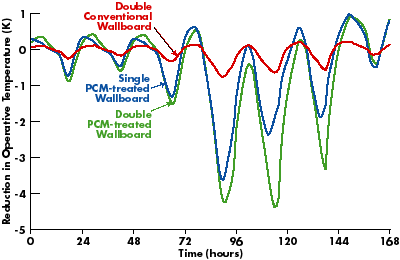
Thermal mass features may be used for storage only or serve as structural elements. Concrete, steel, adobe, stone, and brick all satisfy requirements for sensible heat storage.

Figure 1. Reduction in operative temperature for double conventional and single and double PCM-treated wallboard, compared with single conventional wallboard.Phase-change materials (PCMs), usually a paraffin that can be embedded in gypsum board, plaster, or other wall-covering material, form a class of building material that functions as a storage medium. Materials undergoing a phase change (freezing, melting, condensing, or boiling) store and release large amounts of heat with small changes in temperature. PCMs for thermal mass typically involve a liquid/solid transition--the PCM solidifies, releasing heat when cooling resources are available, and liquifies, absorbing heat when cooling is needed. PCMs offer an order of magnitude increase in heat capacity, and for pure substances they discharge their heat with almost no change in temperature.
PCM allows the thermal storage to become part of the building's structure, permitting substantial energy storage without changing the temperature of the room envelope. Because the heat is stored within the building where the loads occur rather than externally, additional energy transport is not required.
We have used RADCOOL, a thermal building simulation program, to perform a numerical evaluation of the latent storage performance of treated wallboard. In the model, each wall is divided into several layers, allowing for the modeling of multilayer walls. The modeled zone is a living room with a 35 m2 (377 ft2) floor area. The window area is 20 percent of the exterior wall area. All walls and the ceiling are covered with PCM-treated wallboard containing 20 percent paraffin; the room was also modeled for a double thickness of PCM-treated wallboard. The living room is assumed to be occupied by four people from 6 a.m. to 10 p.m. Climate conditions used in the model are those of June 11 through June 17, 1991, in Sunnyvale, California. The first three days of this period were mild; on day four, outdoor temperature reaches almost 40šC (104šF), and remained high for two more days. The room receives ventilative cooling, 10 air changes per hour below 25šC (77šF) and 1.5 ACH above 25šC.
Model outputs include the air temperature and operative temperature profiles of the room with conventional versus single-thickness PCM wallboard, and conventional versus double-thickness PCM wallboard. (Operative temperature is a measure of perceived temperature.) The model also generates outputs of the temperature difference between the wall surface and the air. The figure at left shows the operative temperature-reduction potential of different types of wallboard as compared to single-thickness conventional wallboard. PCM-treated wallboard reduces operative temperature on the first day of the heat spell, day four, but saturation of the latent storage diminishes its reduction potential thereafter. Doubling the PCM-treated wallboard significantly improves operative temperature reduction.
To reconcile the flammability of paraffin with the traditional use of wallboard as fire retardant in construction, we performed a similar numerical evaluation for a "covered PCM wallboard" consisting of single-thickness PCM wallboard containing 40 percent paraffin, covered by a single thickness of conventional wallboard. Our results indicate that the operative temperature reduction potential of "covered PCM wallboard" is similar to that of double-thickness PCM wallboard containing 20 percent paraffin.
The extended storage capacity of double-PCM-treated wallboard can keep room temperatures close to the upper comfort limits without mechanical cooling. In climates with large diurnal temperature swings, night-time ventilation can be used to discharge the latent storage of the wallboard.
--Helmut Feustel and Corina Stetiu
![]()
Helmut Feustel
(510) 486-4021
Corina Stetiu
(510) 486-6186
Indoor Environment Program
(510) 486-6658 fax
* For more information, please contact Corina Stetiu and request "Thermal Performance of Phase Change Wallboard for Residential Cooling Applications," H.E. Feustel and C. Stetiu, LBL-38320.
This research is supported by DOE's Office of Building Technology, State and Community Programs, and the California Institute for Energy Efficiency.